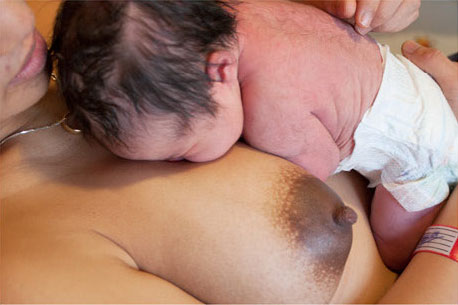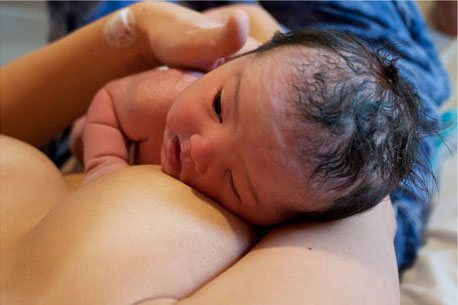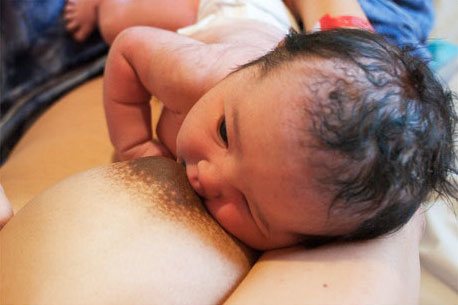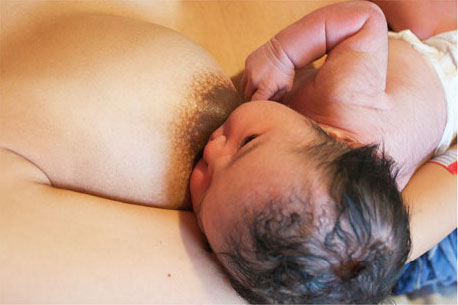Getting started with breastfeeding
Skin-to-skin contact between you and your baby is important after birth to encourage bonding and release hormones that assist breastfeeding. Not all babies are able to feed immediately after birth. The first feed is when you and your baby are ready.
How breastfeeding works
The more your baby feeds, the more milk is produced. When your baby sucks at the breast, hormones are released in your body. These hormones make breast milk and cause the milk to ‘let down’ or flow.
The first milk you produce looks thick and yellowish. This first milk (colostrum) is important for your baby as it contains substances to nourish and protect from disease. The milk gradually becomes thinner and more watery looking. This is normal. Your milk contains everything your baby needs to grow and satisfy their hunger.
More information about breastfeeding is available from the Australian Breastfeeding Association (external site).
The first few days
- Following birth, skin-to-skin contact should be maintained with your baby for one hour or until he or she has breastfed, and then as often as possible after this.
- The early use of teats and dummies, especially before the first breastfeed, can interfere with breastfeeding.
- Common practices such as early weighing, bathing or passing around your baby should be delayed until after the first feed if possible.
- After an initial alert period some babies become very sleepy for the next 24 hours or so. This may be due to the birth experience and/or pain relieving drugs given to the mother during labour. If this happens, colostrum or breast milk will need to be expressed and given to the baby if he or she is not interested in feeding.
- A breastfed baby may feed between 8 to 12 times, or more, every 24 hours.
The best way for you and your baby to learn to breastfeed is to let your baby follow their natural instincts. This is called ‘baby-led attachment’ and can be done straight after birth or at any time later.
Helping your baby to breastfeed

Place your baby in a supported, upright skin-to-skin position on your chest. Calm your baby by gently rocking, stroking and talking.
- Start when your baby is awake and calm and remove his clothes, except for the nappy. Leave your baby’s hands free to move.
- Take off your bra and top – you could wear something over your shoulders for warmth or privacy.
- Sit comfortably, leaning back a little, with your back well-supported. How you and your baby are positioned may help him or her to latch on more easily.

Your baby's instinct is to 'bob' around on your chest searching for your nipple.
- Place your baby skin-to-skin on your chest. Talk to him, look into his eyes and gently stroke him.
- Gently support your baby behind his shoulders and under his bottom, but allow him to move freely when he wants. He may ‘bob’ his head on your chest and then move across to one breast.

Your baby may nuzzle your breast and lick for a little while. That is fine.
- Your baby’s chin is on the breast and your nipple is above your baby’s top lip, opposite the nose.

Your baby will use its cheek to feel the way. This is a learning process for both of you. It is okay to take your time.
- Your baby’s bottom lip and chin should be firmly contacting the breast below the nipple

Your baby will reach up with an open mouth and attach to the breast.
- When his chin contacts the breast, he may attach by himself. Don’t be in hurry. Let your baby take his time to attach when he is ready. Enjoy your baby!

If your baby's back is straight with your bodies touching and you are both feeling comfortable, this is all that matters.
- If your baby is unable to latch on, seek guidance from a lactation consultant (see Support Services)
Rooming in – feeding according to need
If both you and your baby are well, you should remain together 24 hours a day while you establish breastfeeding. This allows unrestricted breastfeeding and helps you learn about your baby's feeding and behaviour patterns.
Where to get help
Perth Metropolitan – Child and Adolescent Health Service (CAHS)
- CAHS child health nurses offer child health appointments (external site), including an initial home visit. The appointments occur at 8 weeks, 4 months, 12 months, and 2 years, with additional appointments if needed and drop-ins at the child health centre.
- Your CAHS Child Health Nurse can refer you to the Child and Adolescent Community Health (CACH) breastfeeding support service.
- For more information, refer to your purple book and magazine (external site) series.
Regional WA - Western Australian Country Health Service (WACHS)
Australian Breastfeeding Association (ABA)
Breastfeeding Centre of WA
Ngala parenting line
- Phone: 9368 9368 – 8.00 am to 8.00 pm 7 days a week
- Outside metropolitan area – Phone: 1800 111 546 (free from land line only)
- Visit the Ngala website (external site)
You can also:
Acknowledgements
Breastfeeding Centre of WA
This publication is provided for education and information purposes only. It is not a substitute for professional medical care. Information about a therapy, service, product or treatment does not imply endorsement and is not intended to replace advice from your healthcare professional. Readers should note that over time currency and completeness of the information may change. All users should seek advice from a qualified healthcare professional for a diagnosis and answers to their medical questions.